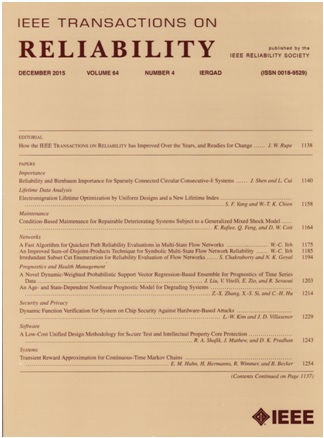基于两阶段模型的个体监测动态可靠性评估方法——以轴承振动数据为例
IF 5.7
2区 计算机科学
Q1 COMPUTER SCIENCE, HARDWARE & ARCHITECTURE
引用次数: 0
摘要
传统的基于退化的可靠性评估方法通常是基于大量类似产品的丰富数据,提供产品性能的平均描述。为了捕捉个体特征,实现个性化维修,提出了一种基于个体监测数据的动态可靠性评估框架,该框架集成了两阶段方案,并结合了物理模型。首先基于巴黎定律构建状态空间模型,结合物理机制和二次随机因素,准确描述轴承退化;然后,提出了一种基于扩展时间窗的在线阶段划分策略,该策略实现了变化点检测并进行参数估计作为先验信息。第二阶段采用扩展卡尔曼滤波自适应估计退化状态分布和模型参数,并基于区间故障率实时评估系统的可靠性。最后,为了验证所提框架的有效性,给出了一个轴承振动数据的对比实例研究。本文章由计算机程序翻译,如有差异,请以英文原文为准。
A Two-Stage Model-Based Dynamic Reliability Evaluation Method in Individual Monitoring: A Case Study on Bearing Vibration Data
Traditional degradation-based reliability evaluation methods are typically based on rich data from a population of similar products, providing an average description of product performance. To capture individual characteristics for personalized maintenance, a dynamic reliability evaluation framework is proposed based on the individual monitoring data, which integrates a two-stage scheme and incorporates the physical model. The state-space model is first constructed based on Paris' Law to accurately describe bearing degradation, combining both physical mechanisms and secondary random factors. Then, an online stage division strategy based on an expanding time window is proposed, which implements change point detection and performs parameter estimation to serve as a priori information. Next, degradation state distributions and model parameters are adaptively estimated in the second stage using the extended Kalman filter, and the reliability is evaluated in real time based on the interval failure rate. Finally, to demonstrate the efficacy of the proposed framework, a comparative practical case study on bearing vibration data is presented.
求助全文
通过发布文献求助,成功后即可免费获取论文全文。
去求助
来源期刊

IEEE Transactions on Reliability
工程技术-工程:电子与电气
CiteScore
12.20
自引率
8.50%
发文量
153
审稿时长
7.5 months
期刊介绍:
IEEE Transactions on Reliability is a refereed journal for the reliability and allied disciplines including, but not limited to, maintainability, physics of failure, life testing, prognostics, design and manufacture for reliability, reliability for systems of systems, network availability, mission success, warranty, safety, and various measures of effectiveness. Topics eligible for publication range from hardware to software, from materials to systems, from consumer and industrial devices to manufacturing plants, from individual items to networks, from techniques for making things better to ways of predicting and measuring behavior in the field. As an engineering subject that supports new and existing technologies, we constantly expand into new areas of the assurance sciences.
 求助内容:
求助内容: 应助结果提醒方式:
应助结果提醒方式:


